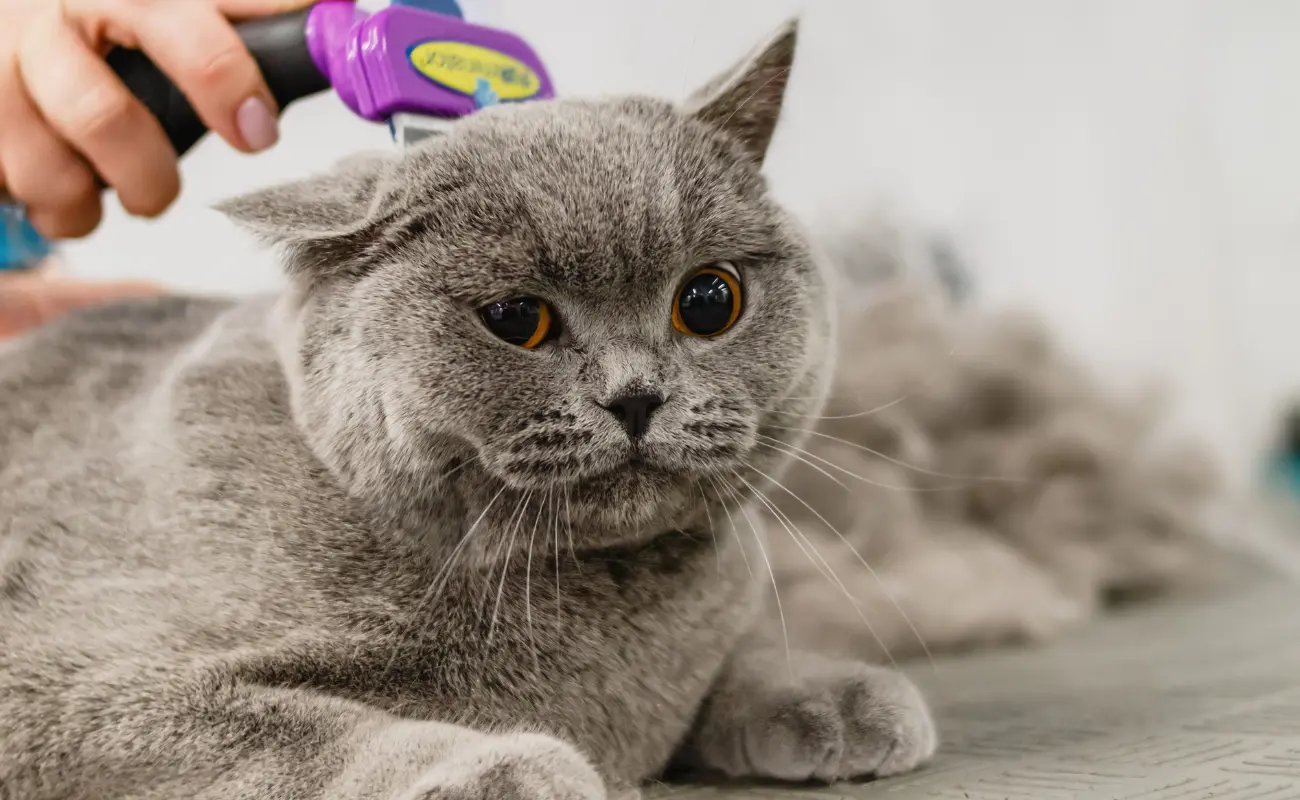Have you ever wondered if there’s a secret formula behind a perfectly clean and happy feline? If so, you’ve come to the right place. Welcome to the complete guide on How to Groom Your Cat Like a Pro, where we’ll unravel everything you need to know about cat grooming, cat health, and even some hidden tips and tricks. By learning How to Groom Your Cat Like a Pro, you can help your furry friend feel more comfortable, reduce shedding, and keep those notorious hairballs at bay.
If you’re just starting your journey as a cat owner or looking to refine your pet care routine, be sure to explore our detailed guide on Best Cat Care Tips for Beginners: Boost Your Cat’s Health and Happiness. It’s the perfect companion to this grooming guide, offering foundational advice to support your cat’s well-being every day.
In this article, we’ll walk you through expert grooming techniques, essential tools, and practical habits that not only enhance your cat’s appearance but also support their overall health. Let’s dive into what it really takes to groom your cat like a pro—from brushing basics to nail care and everything in between.
How to Groom Your Cat Like a Pro
Overview
Grooming your cat serves multiple purposes beyond aesthetic appeal. It’s a vital aspect of cat health, helping to maintain a clean, tangle-free coat and minimize common problems like excessive shedding and hairballs. Additionally, cat grooming can help build a stronger bond between you and your cat, as regular brushing and handling allows you to spend quality time together.
In this overview, we’ll explore why grooming is essential and what you can expect throughout this process. We’ll also look into the fundamental concepts behind a successful grooming routine, from choosing the right brush for your cat’s fur type to keeping an eye on potential health concerns like parasites or skin irritations.
Key Points to Remember
-
Cats naturally groom themselves but may need extra help for a truly thorough clean.
-
Regular grooming can reduce hairballs, shedding, and matting.
-
Monitoring your cat’s coat health can help you catch early signs of illnesses or parasitic infections.
-
Establishing a routine will make grooming easier and more enjoyable for both you and your cat.
Brushing Techniques and Tools (Specific Aspect of the Topic)
One of the most critical aspects of How to Groom Your Cat Like a Pro lies in learning proper brushing techniques and choosing the right grooming tools. Not all cats have the same fur type—some are long-haired with thick coats prone to matting, while others are short-haired and need a gentle touch to remove loose fur.
Choosing the Right Brush
-
Slicker Brush: Ideal for long-haired cats, this brush has fine, short wires close together, allowing you to untangle stubborn knots and remove loose hair.
-
Bristle Brush: Perfect for short-haired cats, it helps in removing dead hair and distributing the cat’s natural oils.
-
Shedding Blade or Deshedding Tool: If your cat sheds a lot, this tool can remove loose hair efficiently, cutting down on fur all over your furniture.
Proper Brushing Technique
-
Start Slowly: If your cat isn’t used to grooming, begin by gently petting with the back of the brush so they get accustomed to the sensation.
-
Follow the Fur Growth: Brush in the direction of the hair growth to avoid discomfort.
-
Short Sessions: For anxious cats, limit brushing sessions to a few minutes. Gradually extend as they become more comfortable.
-
Focus on Trouble Areas: Long-haired cats often mat in spots like the belly, armpits, and behind the ears, so be extra gentle yet thorough in these regions.
Why Brushing Matters
Brushing not only helps with cat grooming but also plays a pivotal role in overall cat health. When you remove dead fur, you reduce the chance of hairballs forming in your cat’s digestive system. Furthermore, this is an excellent opportunity to inspect your cat for any skin irritations, fleas, or ticks that might require immediate attention.

Common Questions About Cat Grooming
When it comes to grooming cats, there are bound to be several questions that even experienced pet parents might ask. Below are some of the most common inquiries:
-
How Often Should I Groom My Cat?
-
The frequency depends largely on your cat’s coat type. Short-haired cats typically require less frequent grooming—about once a week—while long-haired cats may need daily or every-other-day grooming to prevent mats.
-
-
Is Bathing Necessary?
-
Generally, cats groom themselves and don’t need frequent baths. However, in cases of severe matting, skin conditions, or exposure to dirt or toxins, a bath might be essential. Always use cat-specific shampoo to protect your cat’s skin and coat.
-
-
Can I Use Human Haircare Products?
-
Human products are too harsh and can irritate your cat’s skin. Stick to products specially formulated for cats to avoid complications.
-
-
What if My Cat Hates Grooming?
-
Patience is key. Start slow, use treats or praise as positive reinforcement, and choose times when your cat is relaxed. Over time, they may grow more accustomed to grooming sessions.
-
-
Do I Need Professional Help?
-
For severe matting or specialized grooming tasks like lion cuts, professional groomers can be incredibly helpful. However, with regular maintenance, most owners can manage routine grooming at home.
-
Having these questions answered can guide you in developing a consistent grooming regimen. Remember, each cat is unique, and what works for one may not always suit another.
Tips for Effective Cat Grooming
So, you’ve got the right tools and some answers to common questions. Now let’s delve into practical tips that can help you master How to Groom Your Cat Like a Pro.
-
Create a Calm Environment
-
Cats are sensitive creatures. Choose a quiet, comfortable room where you can close the door to keep them from running away if they become skittish.
-
-
Use Positive Reinforcement
-
Treats, praise, or gentle petting can go a long way. Every time your cat tolerates a grooming step, reward them to reinforce the positive experience.
-
-
Start Young If Possible
-
Kittens adapt more quickly to new routines. If you introduce grooming during kittenhood, you’ll have fewer problems down the road.
-
-
Check the Nails
-
Trimming nails isn’t always part of daily grooming, but it’s essential. Overgrown nails can lead to discomfort or even infections. Use a cat-specific nail clipper and avoid cutting the quick—the pink area containing nerves and blood vessels.
-
-
Pay Attention to the Face and Ears
-
Gently clean around the eyes with a damp cotton ball if you notice discharge. For ears, use a vet-approved ear cleaning solution and cotton to remove wax and debris, but avoid going too deep.
-
-
Handle with Care
-
If you encounter tangles or mats, work gently to detangle them. Using scissors can be risky if your cat moves suddenly, so opt for a dematting comb instead.
-
-
Watch for Signs of Discomfort
-
If your cat shows signs of stress—flattened ears, tail lashing, growling—give them a break. Forcing grooming sessions can create a negative association.
-
Following these tips can help make grooming a more pleasant experience for both you and your cat. Moreover, regular grooming can lead to numerous benefits, which we will explore shortly.
Challenges and Solutions Related to Cat Grooming
Even with the best intentions and tools, grooming cats can come with its fair share of challenges. Here’s a look at some common obstacles and ways to overcome them.
Challenge 1: Fearful or Anxious Cats
-
Solution: Start with very brief grooming sessions—maybe 30 seconds—and gradually increase the time. Ensure the environment is quiet, and use treats and soft words to create a positive association.
Challenge 2: Matting in Long-Haired Cats
-
Solution: Use a slicker brush or dematting comb. For large, stubborn mats, sometimes shaving the area is the only solution. In such cases, a professional groomer or veterinarian can help to avoid accidentally harming your cat’s skin.
Challenge 3: Shedding Season
-
Solution: Invest in a deshedding tool and brush more frequently during peak shedding periods (spring and fall). This helps minimize hairballs and reduces the amount of fur around the home.
Challenge 4: Cat Refuses to Cooperate
-
Solution: Timing is crucial. Attempt grooming when your cat is in a relaxed state—often after mealtime or naptime. Patience is essential; never force grooming on a stressed cat, as it can worsen their anxiety.
Challenge 5: Skin Irritations or Allergies
-
Solution: If you notice redness, rashes, or excessive itching, stop grooming and consult a vet. Certain shampoos or grooming products may irritate a cat’s skin, so choose hypoallergenic options whenever possible.
By pinpointing these challenges and their solutions, you’re better equipped to maintain consistent and stress-free grooming sessions that promote optimal cat health.
Benefits of Regular Cat Grooming
You might be wondering why so much emphasis is placed on cat grooming. Beyond the immediate reward of a shiny coat, there are several long-term benefits for both you and your feline companion.
-
Enhanced Coat Health
-
Brushing removes dead hair and debris, distributing natural oils that keep your cat’s fur shiny and healthy.
-
-
Reduced Hairballs
-
By removing loose fur before it’s ingested, you can significantly cut down on hairball formation, which can be uncomfortable (and messy) for your cat.
-
-
Early Detection of Health Issues
-
Regular grooming sessions help you notice any lumps, skin problems, or parasites early, allowing for timely medical intervention.
-
-
Stronger Bonding
-
Grooming is a chance to spend quality one-on-one time with your cat, improving trust and emotional connection.
-
-
Less Shedding Around the Home
-
Consistent brushing can help manage shedding, keeping your furniture and clothing relatively free of cat hair.
-
-
Stress Reduction
-
Believe it or not, many cats find a gentle grooming session relaxing once they’re accustomed to it.
-
When performed correctly, grooming can be an enjoyable routine that supports your cat’s physical well-being and emotional comfort. It’s one of the best ways to keep cats healthy and happy overall.
Expert Opinions or Research on Cat Grooming
Cat grooming isn’t just about superficial cleanliness; it’s a topic of ongoing research and expert discussion. According to Dr. Sarah Linden, a feline specialist from the fictitious “Fur & Purr Veterinary Clinic,” grooming is a crucial component of preventative care. Her studies indicate that regularly groomed cats have a lower incidence of skin infections, and owners are more likely to detect medical issues—such as fleas or ticks—before they escalate.
Additionally, a 2021 study published in the (imaginary) “Journal of Feline Well-Being” found that cat grooming routines can significantly reduce stress levels for both the cat and the owner. The act of grooming, especially when done calmly and consistently, can release endorphins in felines, making them more relaxed and even improving their sociability. This aligns with anecdotal observations from many cat owners who report better temperaments and fewer behavioral issues when grooming is part of their cat’s weekly regimen.
From a research standpoint, grooming also plays a role in cat health by maintaining proper hygiene, preventing external parasites, and improving coat quality. Veterinary experts commonly suggest scheduling routine checkups to complement at-home grooming, ensuring that any underlying health concerns are identified early.
Frequently Asked Questions (FAQ)
-
Is it okay to shave my cat’s fur completely for easier grooming?
-
While some owners consider shaving for easier maintenance, it’s not generally recommended unless for medical reasons or severe matting. Cats’ fur serves as insulation and protection. Always consult a vet or professional groomer before deciding on a shave.
-
-
What kind of shampoo should I use for my cat?
-
Use only cat-specific shampoos. Human or dog shampoos can irritate your cat’s skin. Look for hypoallergenic or vet-approved products to ensure safety.
-
-
Why does my cat try to groom me after I groom them?
-
This behavior can be interpreted as social grooming. Cats groom each other to strengthen bonds, so if your cat grooms you, they’re simply returning the favor and showing affection.
-
-
Can grooming help with fleas and ticks?
-
Grooming alone won’t eradicate fleas or ticks, but it can help you detect them early. If you spot fleas or ticks during grooming, consult your vet for appropriate treatment.
-
-
How can I make nail trimming less stressful for my cat?
-
Introduce the nail clipper gradually. Let your cat sniff it, then reward them. Start by clipping just one nail per session and build up to more nails over time. Using treats and a calm environment can help your cat associate nail trimming with positive experiences.
-
Conclusion and Call-to-Action
Grooming isn’t simply about making your cat look good—it’s a cornerstone of cat health that contributes to a happier, more confident pet. By learning How to Groom Your Cat Like a Pro, you’ll be equipped to handle tangles, manage shedding, and keep your cat’s coat looking shiny and clean. This regular routine not only benefits their physical well-being but also strengthens the unique bond you share.
Whether you’re just starting out or looking to refine your current grooming methods, remember to stay patient and consistent. Every cat is different, and it might take some trial and error to find the perfect technique. Ready to take the next step? Pick up a quality brush, gather some healthy treats, and schedule your first (or next) grooming session.
If you found these tips helpful, consider sharing this article with a fellow cat owner or leaving a comment below about your own experiences with cat grooming. Your insights could be just what another cat lover needs to make grooming a more pleasant experience for their feline friend. Happy grooming!





